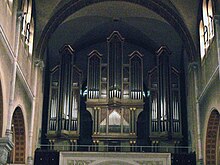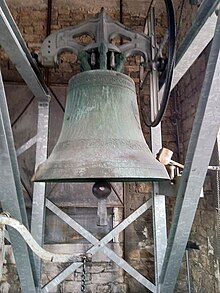St. Martin (Olten)
St. Martin is a Roman Catholic church in the town of Olten ( Switzerland ). It is a three-aisled pillar basilica without a transept with three choir apses .
history
The Martins - Patrozinium points to a great age of the parish. However, many old documents were burned in the town fire of 1422, which also destroyed the town church. The new building, a simple hall church with a turret , was not consecrated until 1461 . In 1521 the church received a representative tower, today's city tower (1676–82 increased by one floor and the baroque dome).
Since 1781 there were plans to build a new city church instead of the existing one, which had become too small. In 1805, the community assembly decided not to build it at the old location, but to the west in front of the medieval city wall on the site of the Holy Cross Chapel from 1603. Work began in 1806, and in 1813 the new St. Martin Church , a classical hall building, was consecrated. The old Martinskirche was profaned and used for various commercial and police purposes until it was demolished in 1844 - except for the tower.
After the First Vatican Council in 1870, the Swiss Kulturkampf broke out , and on June 14, 1875 the constituent national synod of the Christian Catholic Church of Switzerland took place in the Olten town church ; the town church belongs to it from 1813 until today.
The remaining Roman Catholic community built an emergency church in 1876 . Next to it, the St. Gallen architect August Hardegger built the large neo-Romanesque parish church from 1908 to 1910, which in turn received the St. Martin's patronage. This has more seats than the St. Ursus Cathedral in Solothurn. Wilhelm Keller's former emergency church was converted into parish rooms and the Josefsaal.
Organs
Main organ
The first organ was built by Orgelbau Goll (Lucerne) with 33 registers , it was damaged by mouse infestation. In 1932 the organ building company Willisau AG built a new organ with 49 registers, which was reorganized in 1949 by the organ builder Goll and expanded to 64 registers. Today's organ was rebuilt in 1992 by Mathis Orgelbau (Näfels). The instrument has 50 stops on three manuals and a pedal . The playing and stop actions are mechanical.

|
|
|
|
|||||||||||||||||||||||||||||||||||||||||||||||||||||||||||||||||||||||||||||||||||||||||||||||||||||||||||||||||||||
Choir organ
Thanks to donations, a small choir organ with 881 pipes in the left aisle at the front, which also comes from the Mathis company, was able to be realized.
Bells
The three old bells of the former emergency church from the Rüetschi house were all donated. Two are ringing today in the African area of activity of the German-speaking Swiss Capuchin missionaries and the Baldegger sisters in Isongo and Kwangulelo, in the Tanzanian dioceses of Mahenge and Arusha. The third can be heard from the Joseph Chapel of the Solidarity Center for Disabled Young People in Taalabaya.
The six new bells were also cast in 1909 by the Rüetschi & co. Bell foundry . (Aarau). They are in the so-called "extended Westminster motif". The four largest bells have the same pitch as the famous ringing in the Elisabeth Tower of London (Big Ben) . There are also two higher tuned bells (hence “extended Westminster”). Bell five and bell one are an octave apart.
All bells hang on the curved cast iron yokes typical of that time and are only sparsely decorated instead of the usual castings of the time. The big bell hangs separately in the right tower, the other five in the left.
- Bell strike tone: Ace 0 , Trinity bell , 5127 kg with the inscription: UNUM DEUM IN TRITATE ET TRITATEM IN UNITATE VENERAMUR. (« We worship the one God in trinity and the trinity in unity.»)
- Bell strike sound: des 1 , Herz Jesu bell, 2110 kg with the inscription: COR JESU MISERERE NOBIS. (« Heart of Jesus have mercy on us.»)
- Bell strikes: es 1 , St. Mary's bell, 1477 kg with the inscription: AVE MARIA GRATIA PLENA. (« Hail Mary , full of graces.»)
- Bell strike: f 1 , St. Josefsglocke, 1045 kg with the inscription: S. JOSEPH PROTECTOR NOSTER IN TERRIS INTERCEDE PRO NOBIS. (« Saint Joseph, our protector on earth, stands up for us.»)
- Bell strike sound: as 1 , St. Martin's bell , 612 kg with the inscription: S. MARTINE ORA PRO NOBIS (« Saint Martin , pray for us.»)
- Bell strike tone: b 1 , St. Michael's bell , 388 kg with the inscription: S. MICHAEL ARCHANGELE DEFENDE NOS IN PROELIO. («Holy Archangel Michael , defend us in battle.»)
The total weight of the bells is: 10,759 kg.
Web links
- Parish of St. Martin Olten
- 100 years Martinskirche on the website of the Catholic Press Association in Olten
Individual evidence
- ↑ Martin Eduard Fischer: The Olten Holy Cross Chapels ( online )
- ↑ Martin Eduard Fischer: The last years of the old town church (2013; online )
- ↑ Internet presence of the Christian Catholic Church of St. Martin ( Memento of the original from February 2, 2018 in the Internet Archive ) Info: The archive link has been inserted automatically and has not yet been checked. Please check the original and archive link according to the instructions and then remove this notice.
- ↑ This was noticed at the episcopal ordination in 2011, when Cardinal Kurt Koch named Felix Gmür as the new bishop. The fair should actually have taken place in Solothurn, but was then moved to Olten because of arson in St. Ursen. In Solothurn, all invited guests would have barely found space, but in Olten there was free seating.
- ↑ More information about the organ
Coordinates: 47 ° 21 '3.8 " N , 7 ° 53' 54.8" E ; CH1903: 634 751 / 244567



